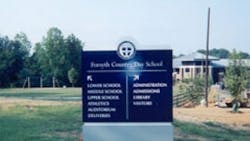Campus signage provides important navigational information, and it reflects an institution's image. Creating a signage system using strategically planned design methodology, precision fabrication, plus well-planned placement, enhances a campus environment. This helps create a positive experience for visitors and prospective students.
An effective and cohesive signage system heightens the excitement of a vibrant and creative institution; on the other hand, a proliferation of wordy signs in unmatched shapes, colors, materials and typefaces creates visual clutter and confusion. First-time visitors, unfamiliar with a campus layout, rely heavily on signage to find their way around, and depend on the institution to make signs understandable and visually appealing.
Through signage, also known as environmental graphics, a school can reinforce its brand identity and image. Often, signage is a visitor's first impression or strengthens preconceived notions. Consistent signage containing a logo or brand creates name reinforcement and a cohesive connection between the environment and the institution. Signage offers a unique opportunity to create value and promote school attributes through its branding.
Developing a program
Navigating a campus involves a series of sign types, each serving a unique function. Designing and planning this integrated system of signs is known as wayfinding. To be effective, wayfinding should have easily accessible information and direction that is provided in a clear visual format.
Professional sign planners can identify sign types systematically and then develop a hierarchy within each type. They list all of the facilities that need identification and then evaluate the need for the various types of signs. Unique sign types:
-
Identification signs name a facility or location. They help visitors and members of the campus community find buildings and facilities, and provide addresses for emergency personnel. Identification signs range from massive entry monuments at campus boundaries, to identification of buildings, to objects as small as restroom door signs.
-
Directional signs guide people to a facility or location. Using combinations of words, arrows and sometimes symbols, they guide people to their destinations.
-
Informational signs provide necessary facts such as hours of operation, areas with Wi-Fi accessibility, and event and lecture schedules. They also can make note of the benefactor, architect and construction date of significant architectural structures.
-
Regulatory signs establish what is and is not permitted. These “behavior-influencing” signs might include stop signs, pool rules signs and signs prohibiting skateboarding.
Functional by design
A cohesive design plan unifies the various sign types in a campuswide sign system. To get the maximum benefit (and efficiency) from campus signage, an institution has to produce a program that emulates the ideals they want to promote. The campus seal, the architectural design of the signs, and the potential use of school colors and logos all have a strong influence on the perception of the school. Designers can incorporate these elements into the master plan for signs.
Sign location affects design as well. Viewing and site conditions affect each sign's design. Local codes, zoning regulations and restrictions can play a critical part in the size, style and location of campus signage, particularly on large campuses.
Finally, design consistency makes an effective campus signage program attractive. To maintain consistency, designers strive for image repetition, and use established size criteria and visual contrast for message legibility. They compare each sign type with others in the program to ensure an integrated look. This thoughtfulness to design has the added benefit of helping a school incorporate future signage.
Mapping the way
A good signage program is more than well-designed signs containing accessible and relevant information positioned at appropriate decision points. It is visual language that creates an accessible, transparent information system.
Successful programs incorporate effective wayfinding that targets new visitors. Members of the campus community familiar with the surroundings do not need signage to guide them or tell them where they are, but new visitors want to know quickly where to go. Inappropriate sign design and placement cause confusion in unfamiliar environments. Signs lacking visibility and legibility from poor copy or color choices, inaccurate or unclear information, or signs obscured by trees or other obstructions all detract from a successful sign program.
Having too many signs can be just as detrimental as having too few. Even visually appealing, consistent, relevant signage overwhelms an environment when there are too many signs. Create a user-friendly program by providing campuswide points of reference that identify current location and potential destination. Once a visitor arrives at a given destination, give detailed information about that specific area to minimize information overload.
In keeping with the “keep it simple” principle, minimizing sign copy helps convey meaning, adds to visual acuity, and creates a more graphically pleasing sign. Simplicity of the sign copy is as important as minimizing the number of signs.
A superior signage system uses key words and consistent design elements to create layers of assistance that visitors are unaware they are using. Successfully achieving this requires finding the best design solution combined with the right size, placement and location for every sign. Visitors should never have to look for a sign; it should be there when they need it. Signage should be easy to read. It should tell visitors exactly what they need to know, and it should lead them effortlessly to their destinations.
Although it isn't necessary to master the technicalities of signage, it is important to understand the important role signage can play and the positive impact it can have on a campus.
Dwight is president of SouthWood Corporation, Charlotte, N.C., which specializes in signage and graphics.
